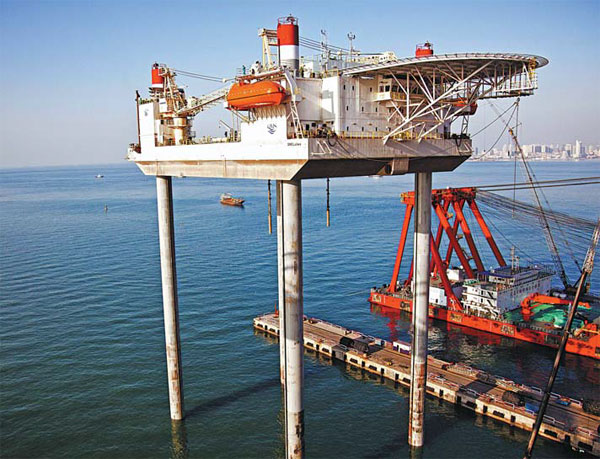Oil, gas firms face 'tough balancing act'
|
An offshore drilling platform in Qingdao, Shandong province. China's long-term energy demand is expected to remain strong in the future. Photos provided to China Daily |
The nation's long-term outlook for energy demand is expected to remain strong, according to an industry report released on Feb 9.
The energy sector faces a tough balancing act in 2015. It was affected by the plunge in oil prices during the second half of last year, which followed prolonged high output levels amid weakening global demand.
The Outlook for the Oil and Gas Industry in 2015, produced by Det Norske Veritas and Germanischer Lloyd, the world's largest risk management company by revenue, said the rising demand is being driven largely by the central government's Energy Development Strategy Action Plan (2014-20) and increasing urbanization.
The factors indicate that international investment would continue to flow into the country's oil and gas sectors.
The report, based on a global survey last month of more than 360 senior industry professionals and executives, found that the United States, China and Norway are expected to be the three most favored investment destinations for 2015. Last year, it was the US, Brazil and Australia.
Wu Yi, regional manager for DNV GL China, said that reassessments and postponements of new investments are expected in light of current oil prices.
China's oil demand will grow 3 percent year-on-year to 534 million metric tons this year, according to the economic and technology research institute of China National Petroleum Corp, the nation's top oil and gas producer.
In 2014, oil consumption grew 3.3 percent to 516 million tons.
However, the report said the biggest barriers to growth for Asia-Pacific respondents are low oil prices, the weak global economy and tougher competition from international rivals. Among respondents globally, the same top two barriers to growth are identified, with the third being gas prices that make the resource unattractive.
International oil prices have seen a significant decline since June. Oil has traded at $44 to $48 per barrel at the beginning of this year, the lowest level since 2009.
"Falling energy prices have heightened the cost management challenge facing the oil and gas industries, as they are forced to spend more to extract reserves amid ever more tightly squeezed margins," Wu says.
Richard Bailey, executive vice-president and director of the Asia-Pacific region and Middle East for DNV GL, says it is positive to note that Asia-Pacific respondents focus on improving work processes as ways to work smarter and more cost-effectively to help ride out the storm.
"Short-term measures such as cutting capital expenditure to reduce costs are understandable. However, the industry must continue to keep a clear focus on long-term growth to remain robust in different price environments," Bailey says.
Jing Yongping, a professor at the Beijing Institute of Petrochemical Technology, says: "The resultant environment will be more difficult than that which companies have had to cope with over the past five years, yet the new reality brings both opportunities and challenges."
Jing says international executives will have tough choices to make on spending, costs, staff levels and growth strategies this year.
At the same time, Jing says, new possibilities should open up, such as the chance to refocus on core projects, ease up on talent pressures and explore more affordable acquisitions in China and the wider Asia-Pacific region.
zhongnan@chinadaily.com.cn



















